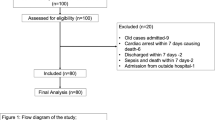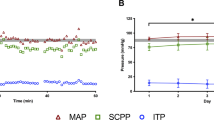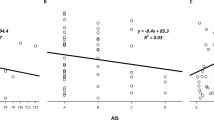Abstract
Study design:
A systematic review of clinical and preclinical literature.
Objective:
To critically evaluate the evidence supporting a role for vasopressor support in the management of acute spinal cord injury and to provide updated recommendations regarding the appropriate clinical application of this therapeutic modality.
Background:
Only few clinical studies exist examining the role of arterial pressure and vasopressors in the context of spinal cord trauma.
Methods:
Medical literature was searched from the earlier available date to July 2009 and 32 articles (animal and human literature) answering the following four questions were studied: what patient groups benefit from vasopressor support, which is the optimal hypertensive drug regimen, which is the optimal duration of the treatment and which is the optimal arterial blood pressure. Outcome measures used were the incidence of patients needing vasopressors, the increase of arterial blood pressure and neurologic improvement.
Results:
Patients with complete cervical cord injuries required vasopressors more frequently than either incomplete injuries or thoracic/lumbar cord injuries (P<0.001). There was no statististical difference in neurologic improvement between patients on vasopressor support with a mean arterial pressure (MAP) of less than 85 mm Hg and those with MAP less than 90 mm Hg. Duration of treatment is often recommended between 5 and 7 days although this is not supported by high-level evidence and no single vasopressor appeared superior over the variety used in clinical treatment.
Conclusion:
There is currently no gold standard on vasopressor support. Based on non-randomized human studies, complete cervical cord injuries require vasopressors more frequently than other spinal cord injuries.
Similar content being viewed by others
Log in or create a free account to read this content
Gain free access to this article, as well as selected content from this journal and more on nature.com
or
References
Lehmann KG, Lane JG, Piepmeier JM, Batsford WP . Cardiovascular abnormalities accompanying acute spinal cord injury in humans: incidence, time course and severity. J Am Coll Cardiol 1987; 10: 46–52.
Piepmeier JM, Lehmann KB, Lane JG . Cardiovascular instability following acute cervical spinal cord trauma. Cent Nerv Syst Trauma 1985; 2: 153–160.
Furlan JC, Fehlings MG . Cardiovascular complications after acute spinal cord injury: pathophysiology, diagnosis, and management. Neurosurg Focus 2008; 25: E13.
Chesnut RM, Marshall LF, Klauber MR, Blunt BA, Baldwin N, Eisenberg HM et al. The role of secondary brain injury in determining outcome from severe head injury. J Trauma 1993; 34: 216–222.
Levi L, Wolf A, Belzberg H . Hemodynamic parameters in patients with acute cervical cord trauma: description, intervention, and prediction of outcome. Neurosurgery 1993; 33: 1007–1016; discussion 1016–17.
Vale FL, Burns J, Jackson AB, Hadley MN . Combined medical and surgical treatment after acute spinal cord injury: results of a prospective pilot study to assess the merits of aggressive medical resuscitation and blood pressure management. J Neurosurg 1997; 87: 239–246.
Consortium for Spinal Cord Medicine. Early acute management in adults with spinal cord injury: a clinical practice guideline for health-care professionals. Spinal Cord Med (May) 2008, 1–69.
Methods of the systematic reviews. In: Eng JJ Teasell RW, Miller WC, Wolfe DL, Twonson AF, Aubut J, Abramson C, Hsieh JTC, Connoly S (eds). Spinal Cord Rehabilitation Evidence. Vancouver, 2006, pp 2.1–2.12. http://www.icord.org/scire; Accessed 1 November 2009.
Clark O, Djulbegovic B . Forest plots in Excel software (data sheet). 2001. http://www.evidencias.com/forest01.xls; Accessed 14 Sep 2009.
Bravo G, Guizar-Sahagun G, Ibarra A, Centurion D, Villalon CM . Cardiovascular alterations after spinal cord injury: an overview. Curr Med Chem Cardiovasc Hematol Agents 2004; 2: 133–148.
Gondim FA, Lopes Jr AC, Oliveira GR, Rodrigues CL, Leal PR, Santos AA et al. Cardiovascular control after spinal cord injury. Curr Vasc Pharmacol 2004; 2: 71–79.
Guha A, Tator CH, Rochon J . Spinal cord blood flow and systemic blood pressure after experimental spinal cord injury in rats. Stroke 1989; 20: 372–377.
Tuli S, Tuli J, Coleman WP, Geisler FH, Krassioukov A . Hemodynamic parameters and timing of surgical decompression in acute cervical spinal cord injury. J Spinal Cord Med 2007; 30: 482–490.
Raw DA, Beattie JK, Hunter JM . Anaesthesia for spinal surgery in adults. Br J Anaesth 2003; 91: 886–904.
Ducker TB, Lucas JT, Wallace CA . Recovery from spinal cord injury. Clin Neurosurg 1983; 30: 495–513.
Blood pressure management after acute spinal cord injury. Neurosurgery 2002; 50: S58–S62.
Stratman RC, Wiesner AM, Smith KM, Cook AM . Hemodynamic management after spinal cord injury. Orthopedics 2008; 31: 252–255.
Nockels RP . Nonoperative management of acute spinal cord injury. Spine 2001; 26: S31–S37.
Walleck CA . Neurologic considerations in the critical care phase. Crit Care Nurs Clin North Am 1990; 2: 357–361.
Fehlings MG, Tator CH, Linden RD . The relationships among the severity of spinal cord injury, motor and somatosensory evoked potentials and spinal cord blood flow. Electroencephalogr Clin Neurophysiol 1989; 74: 241–259.
Fehlings MG, Tator CH, Linden RD . The effect of nimodipine and dextran on axonal function and blood flow following experimental spinal cord injury. J Neurosurg 1989; 71: 403–416.
Stevens RD, Bhardwaj A, Kirsch JR, Mirski MA . Critical care and perioperative management in traumatic spinal cord injury. J Neurosurg Anesthesiol 2003; 15: 215–229.
Adams Jr AC, Biffl WL, Cioffi WG . Surgical critical care, cardiovascular system. In: Townsend Jr CM (ed). Sabiston Textbook of Surgery. Saunders: Philadelphia, 2007.
Ball PA . Critical care of spinal cord injury. Spine 2001; 26: S27–S30.
Stjernberg L, Blumberg H, Wallin BG . Sympathetic activity in man after spinal cord injury. Outflow to muscle below the lesion. Brain 1986; 109 (Part 4): 695–715.
Hambly PR, Martin B . Anaesthesia for chronic spinal cord lesions. Anaesthesia 1998; 53: 273–289.
Ko HY, Ditunno Jr JF, Graziani V, Little JW . The pattern of reflex recovery during spinal shock. Spinal Cord 1999; 37: 402–409.
Weinstein DE, Ko HY, Graziani V, Ditunno Jr JF . Prognostic significance of the delayed plantar reflex following spinal cord injury. J Spinal Cord Med 1997; 20: 207–211.
Yashon D, Bingham Jr WG, Faddoul EM, Hunt WE . Edema of the spinal cord following experimental impact trauma. J Neurosurg 1973; 38: 693–697.
Wolf A, Levi L, Mirvis S, Ragheb J, Huhn S, Rigamonti D et al. Operative management of bilateral facet dislocation. J Neurosurg 1991; 75: 883–890.
Fawcett JW, Curt A, Steeves JD, Coleman WP, Tuszynski MH, Lammertse D et al. Guidelines for the conduct of clinical trials for spinal cord injury as developed by the ICCP panel: spontaneous recovery after spinal cord injury and statistical power needed for therapeutic clinical trials. Spinal Cord 2007; 45: 190–205.
Kwon BK, Curt A, Belanger LM, Bernardo A, Chan D, Markez JA et al. Intrathecal pressure monitoring and cerebrospinal fluid drainage in acute spinal cord injury: a prospective randomized trial. J Neurosurg Spine 2009; 10: 181–193.
Wallace MC, Tator CH . Successful improvement of blood pressure, cardiac output, and spinal cord blood flow after experimental spinal cord injury. Neurosurgery 1987; 20: 710–715.
Wallace MC, Tator CH . Failure of naloxone to improve spinal cord blood flow and cardiac output after spinal cord injury. Neurosurgery 1986; 18: 428–432.
Dolan EJ, Tator CH . The treatment of hypotension due to acute experimental spinal cord compression injury. Surg Neurol 1980; 13: 380–384.
Guha A, Tator CH, Smith CR, Piper I . Improvement in post-traumatic spinal cord blood flow with a combination of a calcium channel blocker and a vasopressor. J Trauma 1989; 29: 1440–1447.
Gambardella G, Collufio D, Caruso GN, Abbate F, Germana G, Tomasello F . Experimental incomplete spinal cord injury: treatment with a combination of nimodipine and adrenaline. J Neurosurg Sci 1995; 39: 67–74.
Ross IB, Tator CH . Further studies of nimodipine in experimental spinal cord injury in the rat. J Neurotrauma 1991; 8: 229–238.
Dyste GN, Hitchon PW, Girton RA, Chapman M . Effect of hetastarch, mannitol, and phenylephrine on spinal cord blood flow following experimental spinal injury. Neurosurgery 1989; 24: 228–235.
Levi L, Wolf A, Rigamonti D, Ragheb J, Mirvis S, Robinson WL . Anterior decompression in cervical spine trauma: does the timing of surgery affect the outcome? Neurosurgery 1991; 29: 216–222.
Bilello JF, Davis JW, Cunningham MA, Groom TF, Lemaster D, Sue LP . Cervical spinal cord injury and the need for cardiovascular intervention. Arch Surg 2003; 138: 1127–1129.
Mathias CJ, Frankel HL, Christensen NJ, Spalding JM . Enhanced pressor response to noradrenaline in patients with cervical spinal cord transection. Brain 1976; 99: 757–770.
Acknowledgements
We thank Mitchell Maltenfort, Department of Neurological Surgery, Thomas Jefferson University, biostatistician, for statistical analysis and help.
Author information
Authors and Affiliations
Corresponding author
Ethics declarations
Competing interests
The authors declare no conflict of interest.
Rights and permissions
About this article
Cite this article
Ploumis, A., Yadlapalli, N., Fehlings, M. et al. A systematic review of the evidence supporting a role for vasopressor support in acute SCI. Spinal Cord 48, 356–362 (2010). https://doi.org/10.1038/sc.2009.150
Received:
Revised:
Accepted:
Published:
Issue date:
DOI: https://doi.org/10.1038/sc.2009.150
Keywords
This article is cited by
-
Meglumine cyclic adenylate improves cardiovascular hemodynamics and motor-function in a rat model of acute T4 thoracic spinal cord injury
Spinal Cord (2023)
-
An investigation to the prolonged requirement (>7 days) of vasopressors in cervical spinal cord injury patients—a retrospective analysis
Spinal Cord Series and Cases (2021)
-
Exploration of surgical blood pressure management and expected motor recovery in individuals with traumatic spinal cord injury
Spinal Cord (2020)
-
Cardio-centric hemodynamic management improves spinal cord oxygenation and mitigates hemorrhage in acute spinal cord injury
Nature Communications (2020)
-
Monitoring spinal cord hemodynamics and tissue oxygenation: a review of the literature with special focus on the near-infrared spectroscopy technique
Spinal Cord (2019)



